Schedule Saturday Night:
3:00-7:00pm – Install at ACH
We will provide dinner!
Break
9:45-11:30pm – Finish install
11:30pm – Doors open for ticketed guests
Schedule Sunday Morning:
8:00am – Breakfast
9:00am – De-Install SNOOZEFEST (clean-up and return items to our classroom)
Mid-way Critique: April 16
Final Critique: May 2
Your final project for the semester is an Independent Project. There are three prompts below to help jump-start your project. You can use any techniques and media you learned during the semester in addition to techniques you have invented yourself or gained elsewhere. You will work on this project mostly outside of class. During class time we will work on the large scale collaborative Dream Pavilion.
Prompt 1:
Create a piece(s) in response to your Research Talk. In responding, consider materials, scale and construction as all these should expand on your relationship to the work and ideas. You may think of this as an imaginary collaboration with the artist, a response to a particular piece, following a material or conceptual curiosity, or, or…
Prompt 2:
Create a new piece or series of pieces – the ones you have been waiting to create all semester! What have you wanted to explore but haven’t yet? What did you discover in the first half of the class that you want to pursue further? What ideas would you like to test out or develop?
Prompt 3:
Dedicate your time outside of class to develop our Dream Pavilion. After the class has decided on the direction of the Dream Pavilion project, your independent project could be to further our collaborative project, including but not limited to: creating sewing patterns, construction, developing details of a specific portion, creating video, developing a lighting schema, etc. If you choose this prompt, you will need to be creating the work in service to the ideas agreed upon by the class and incorporate feedback along the way. Also, you will need to document your process and specific contributions to the collaborative project.
Important Dates:
April 4: Proposal. Upload your proposal to Canvas. It should include a one- page written description, drawings, and a timeline for yourself.
April 16: Bring in your work for a mid-way critique
May 2: Project due for final critique. Come prepared to share your Independent Project with the class for critique. Upload documentation to the class website by one week after the due date.
PDF of the Independent Project Rubric
]]>
Our class will create an inflatable environment for an overnight concert event held in collaboration with the Exploded Ensemble. Members of the Exploded Ensemble plus visiting professional musicians will perform from midnight to 9am April 28-April 29. The environment will be the visual, spatial and textural experience of the evening. It can be one structure, multiple structures, one sculpture, or a collection of sculptures. The concert event will take place in the ACH (Alumni Concert Hall) in the CFA Building. Over the next three weeks, your group is to create proposal and mock-up/model of an idea to present to the class.
Elements of your proposal:
- Organized Digital Folder of all drawings, sketches, research, brainstorming, and notes from meetings. Take turns being a note-taker at all of your group meetings.
- Drawn (by-hand and/or on computer) image(s) of proposed environment.
- Written description of idea and concept (1-3 paragraphs).
- Birds-eye-view drawing of where fans, outlets, musicians and environmental elements will be located.
- Mock-up / Model of environment
- First draft of a pattern and estimate of materials needed.
Timeline to follow:
- Feb. 28 (today) – collect contact info for all members of your group. Schedule a time to meet just before Spring Break.
- Feb. 28-Mar. 7 – Before you go to your group’s first meeting, find 2 hours to go the ACH to sketch and draw ideas for the environment. ACH schedule url: http://bit.ly/CFA-ACH
- Mar. 5-Mar. 12 – Before Spring Break, meet with your group to share your sketched ideas and brainstorm new ones. Decide on how you want to share and/or distribute the tasks and next steps.
- Mar. 19 – In-class proposal check-in with Olivia.
- Mar. 19-25 – Meet again, or multiple times, with group to finalize proposal and elements.
When brainstorming the design for the environment, keep the following in mind:
- The working title and theme for the event is Nocturnes
- There will need to be a place for the musicians to set-up equipment with access to nearby outlets and perform (note plan on reverse)
- The environment should be wheelchair accessible
- Up to 75 people will be staying overnight and lying down during the concert event
- Another 100 people may come and go during the evening
- Color-changing lights will be used and should be considered.
- We can use all the ripstop we have already, plus could buy another 100 yards of two different colors. If other materials are also needed, we may be able to purchase those too.
Some questions to think about:
- What would you like people to see as they are looking up when lying down?
- How would like people to flow through the space?
- How will people enter and exit?
- What is the overall feeling you imagine for the event? Does it change over time?
- Where will the fans go?
- What is a minimal sculptural gesture to alter the space?
- What is a maximal sculptural gesture to alter the space?
Come prepared to share your proposals with the class for discussion. Upload your proposals to the class website by due date, March 26.
ACH Basic Layout
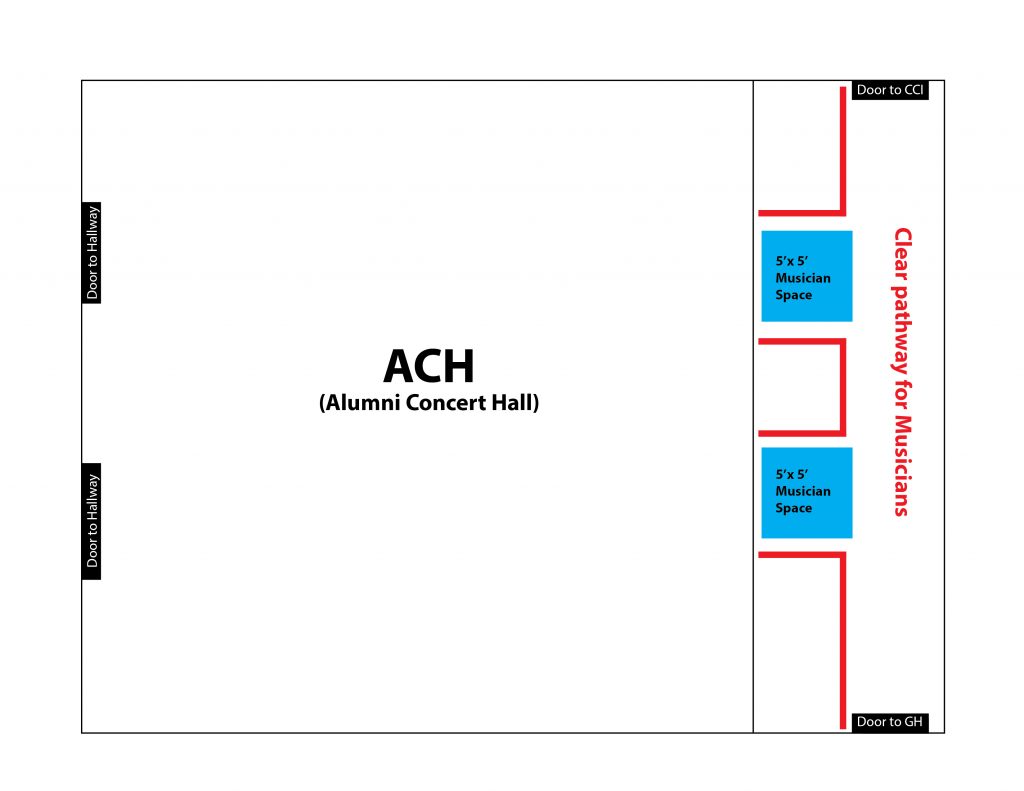
“Doppelgänger: (German “double walker”) is a paranormal double of a living person, typically representing evil or misfortune. In modern vernacular, the word has come to refer to any double or look-alike of a person.” (Wikipedia.org)
Without thinking too hard, select an object from your life that you will replicate in cloth. Using the pattern-making skills and sewing construction techniques we’ve learned in class, make a textile doppelgänger of your object. We will use time in class to begin the patterning work. For those with very complex items, select a portion of your object to reproduce in cloth.
You can make your doppelgänger the same size, smaller or larger. Shifts in scale must be attended to—if you are re-creating a tiny porcelain figure in cloth, you must hand-sew in the small details. On the other hand, if you are going large, remember to scale up all materials—thread might become rope when sewing a large sculpture.
We will briefly share these in class, though there will not be a formal critique. Upload documentation to the class website by one week after the due date.

For this assignment you will continue to work with your same partner to create an enlarged, inflatable version of your Animal Collage. Your enlargement needs to be at a scale of 1 inch to 9 inches. In other words, for every 1 inch of your Animal Collage, your pattern will be enlarged to 9 inches on your Large Hybrid version. Since you are now intimate with the patterns for your animals – what will you do differently making this a second time?
Some ideas to consider:
- How does the change in scale affect your choices in color or surface pattern?
- How will the installation your Hybrid affect our experience of it?
- Are there changes to the patterns that you envision for the larger version?
- Lighting can also be a fun element to play with for the inflatables.
- This is not a holiday lawn ornament. Keep it surprising for us!
Design Parameters:
- Use mainly the black and white ripstop nylon.
- Use up to 1 yard of 1 other color (not black or white), but no more.
You will be provided with ripstop nylon to use for this assignment. Please be cognizant of not wasting material as you cut out your pattern pieces – it is our shared resource and will also be used for future assignments.
In class you will be shown techniques for enlarging the patterns, creating inflation inlets, and using fans. You are also welcome to invent your own techniques. Here is a guide for using the HP Designjet T120 Plotter.
Come prepared to share your inflatables with the class for critique. Upload documentation to the class website by one week after the due date.
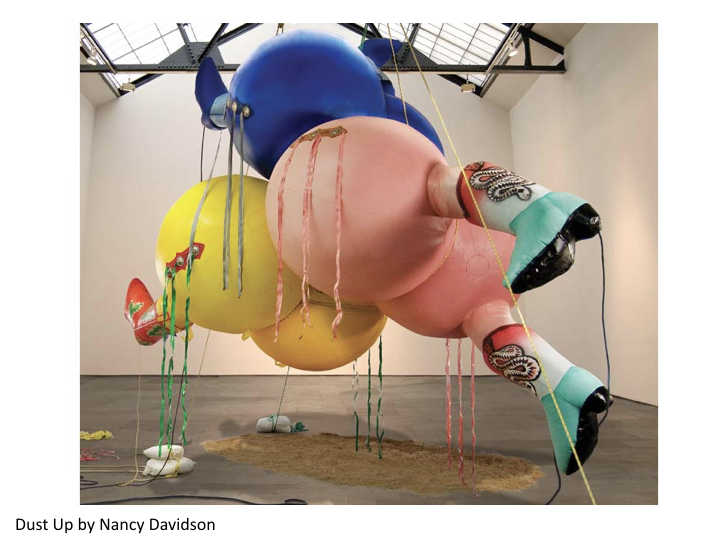
Choose Topic: 2/7
Bibliography & Outline uploaded to Canvas: 2/14 (in the Research Presentation assignment) Presentation: Group 1: 2/26 & Group 2: 2/28
Choose an architect, artist, designer, engineer, collective, or movement that uses soft sculpture or inflatables to research and present as a slide talk. Investigate a topic that is of particular interest to you and share your findings with the class, while building your research and presentation skills. Compose an approximately 10 min talk with good projected images and confident and informative narration.
Requirements:
- Your bibliography should be in MLA formatting and style standards.
- Bibliography must contain at least 3 non-internet sources.
- The presentation must be at least 8 minutes and may not exceed 10 minutes.
- Please limit the number of visuals to 18-20. Low resolution downloads are not acceptable.
- Do not project the text of your talk (titles, credits, etc. are fine).
- Research Presentation Rubric
discovery – what does the architect/artist/designer/engineer discover through creating their work?
narrative of work – how did it change over time? what was the context of the times when they presented the work? what is the breadth of the work?
interest – what is most interesting or inspiring to you?
mechanics – how the work was made? how was it paid for? was there help making it?
what others say – what do critics or other architects/artists/designers/engineers think of the work?
Some possible architects/artists/designers/topics: (…or you could suggest a subject to talk about!)
| Maren Hassinger | Empowerment Project | Michael Rackowitz |
| Louise Bourgeois | Lucy McRae | Senga Nengudi |
| Margarita Cabrera | Claes Oldenberg & Coosje van Bruggen | museo aero solar |
| Charles LeDray | Laura Ford | Sutee Kunavichayanont |
| Lucy Orta | Utopian Infl. Architecture (genre) | Rosa Verloop |
| Tomas Saraceno | Inflatables in Fashion | Abeer Seikaly |
| Nils Voelker | Space Inflatables | Numen |
| Christo and Jeanne Claude | Penique Productions | Victorine Müller |
| Iris Van Herpen | Pneu Haus | Azzedine Alaia |
| Sebastian Di Mauro | Keg de Souza | Claire Watson |
| Lauren Berkowitz | Raumlabor | Amina Robinson |
| Do Ho Suh | Victorine Muller | Gareth Pugh |
| Hans Hemmert | Joshua Allen Harris | Jann Haworth |
| Pat Olezsko | Mycket | Jessica Wohl |
| Annette Messager | Inflatable robotics | Max Streicher |
| Mike Kelly | Ernesto Neto | Ant Farm |
| Lee Boroson | Magdalena Abakanowicz | Tristan Lowe |
| Yayoi Kusama | Olek | Allyson Mitchell |
| Anicka Yi | Sonia Clark | Joanna Vasconcelos |
| Paul McCarthy | Big M | Alex Schweder |
| John Locke | Unipart Structure | Tony Oursler |
| Architects of Air | Rachael Shannon |
Lorem ipsum dolor sit amet, consectetur adipiscing elit. Ut finibus nisl sit amet neque ultricies, a ultricies odio aliquam. Sed dictum convallis tempus. Morbi libero arcu, mollis iaculis ornare id, facilisis ut nibh. Suspendisse in enim in nulla mollis ullamcorper vitae quis eros. Praesent a elementum velit. Orci varius natoque penatibus et magnis dis parturient montes, nascetur ridiculus mus. Donec hendrerit maximus ex, at pulvinar orci pretium vel. Integer sollicitudin fringilla eleifend. Sed quis nisl venenatis nisi finibus auctor. Integer venenatis mauris id nibh consectetur, ut dignissim nisl ullamcorper. Mauris viverra luctus magna.
Nullam malesuada sem in lectus convallis commodo. Suspendisse auctor ante in dignissim placerat. In ac mollis est. Proin vehicula metus sed nisi malesuada laoreet. Fusce lobortis felis vel lectus malesuada placerat. Nunc egestas sit amet ligula ut varius. Nullam sollicitudin, arcu vitae posuere congue, ante massa faucibus metus, at ultrices ante dolor vel eros. Praesent sit amet faucibus turpis. Suspendisse eu augue id ipsum pharetra volutpat. Cras porttitor, lectus quis porttitor egestas, risus purus cursus mi, eu dictum turpis sapien a orci.
Include photograph or video documentation in the post.
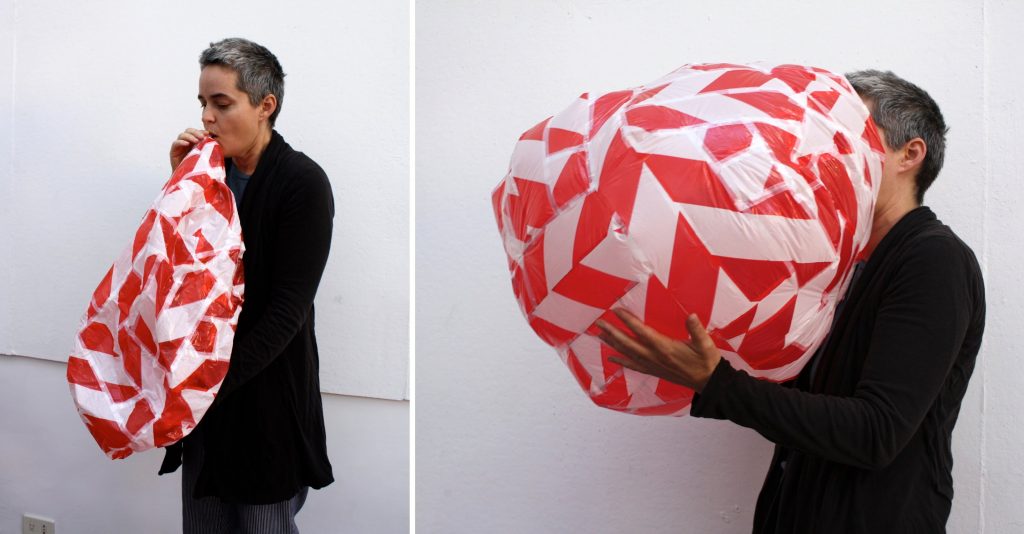
photo of Anna Hepler with pieces from her Addendum exhibition
]]>- On our class website, click on the “Log In” button under “Meta” on the right side of the screen.
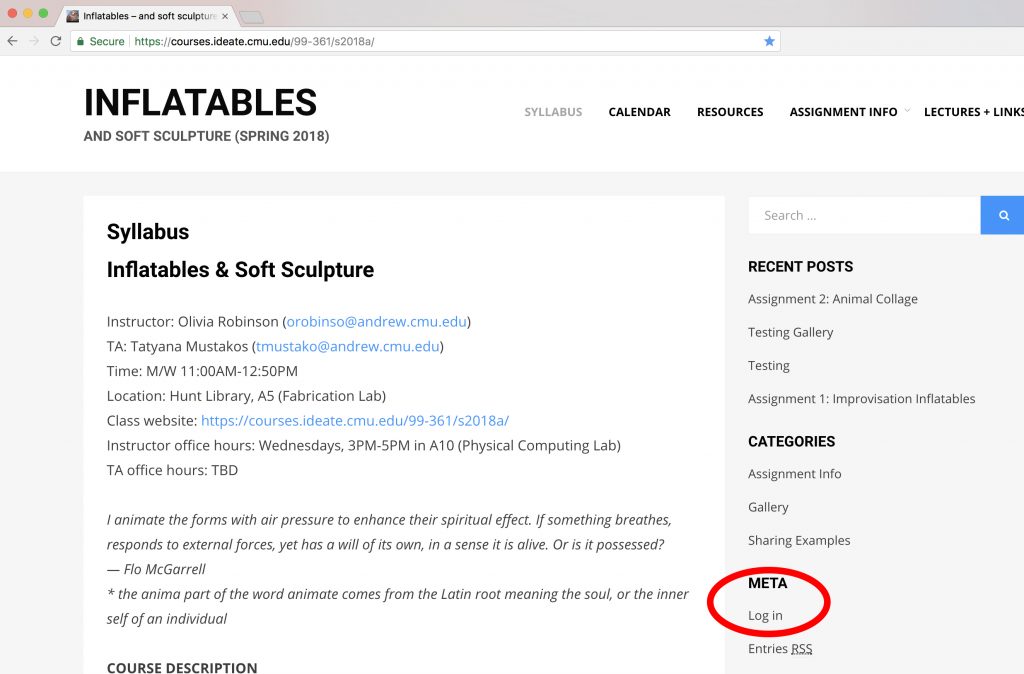
2. You will be prompted to this login page. Use your CMU login and password to sign in.

3. You will need to make a new Post. To do this, hover over “Posts” on the left-hand navigation bar to reveal more post options. Then click on “Add New”.
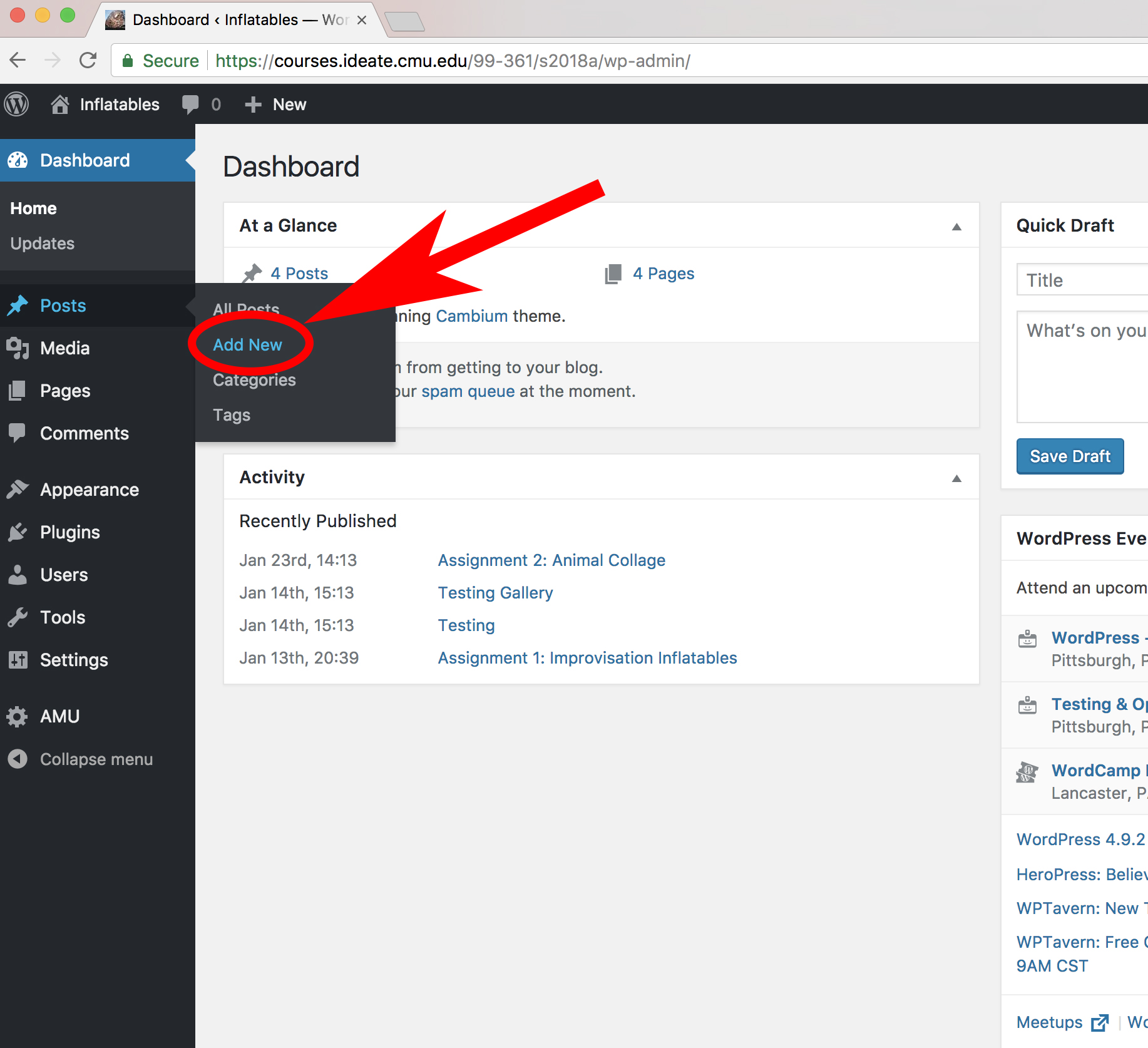
4. Create your post. Make sure that “Gallery” is selected under “Categories” on the righthand navigation bar. Your post should include:
- one paragraph about your project with reflection on what you learned, what you would want to try next if you were to continue, and what you might do differently.
- photographs or video documentations of your project. To include photos, click “add media”. To include video, upload your video through youtube, vimeo or any other online video site, and then click “add media” to input the url into the appropriate field.
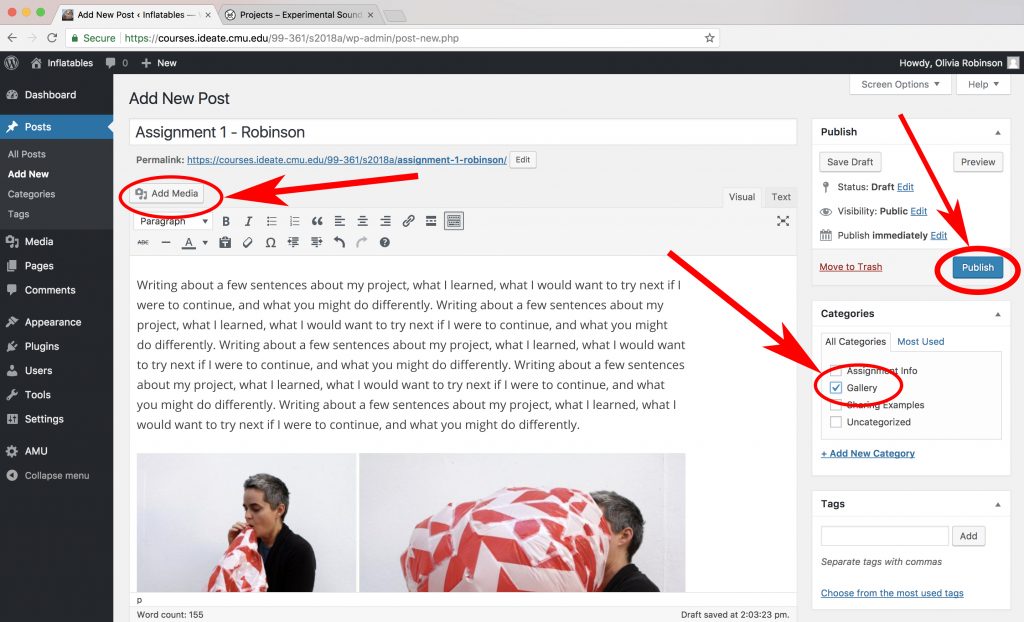
5. When you are finished creating your post, hit “Publish” in order to make the post public and available on our class website.
]]>For this assignment, you will work with a new partner to create a soft sculpture that collages together two animal forms. The spirit of this assignment is to use two found patterns (of two animals) and transform them into something creative and new by combining them together. You and your partner should choose two different animals from the patterns we provide you in class. You are also provided with a number of different fabrics to choose from, or you can use fabrics you have found on your own. The purpose of this assignment is to develop your technical skill in using patterns and sewing, as well as to develop your creativity, flexibility and experimentation.
Here are a few ideas that might inspire your direction:
- Imagine a cloning or GMO project that goes awry. What is the resulting animal?
- Imagine the animals were born conjoined and are connected in unusual ways.
- Imagine a new mythic creature and took on elements from each animal.
- Feel free to play with repetition, such as you could have many legs, tails, ears, etc.
- You can also play with scale with your new animal, for example: what if the tails were exceptionally long? or the feet exceptionally big? (you can enlarge those pattern pieces by using a xerox machine)
You will also need to think about what your new animal is stuffed with. The filling will affect the feel, weight, posture, and character of the new animal. We will provide some basic polyfill stuffing material, but you can also experiment with the stuffing. Here are few possibilities:
- polyfill
- rice
- dried beans or lentils
- sand
- foam
Very important reminder: You must add a 1/4″ or 1/2″ seam allowance on to all of the patterns when you cut them out of fabric. While most store bought patterns will already include seam allowance, these particular patterns do NOT include seam allowance so you must add them.
Come prepared to share your inflatables with the class for critique. Upload documentation to the class website by one week after the due date.
Basic Animal Patterns and Instructions:
Templates
Folder of Instructions
More Complex Animal Patterns & Instructions:
Template Sheet – Side A and Side B (multiple page pdf)
Template FULL SIZE Sheet – Side A and Side B
Instructions
For your first assignment, you will work with a partner to create five inflatables inspired by Anna Hepler’s breath inflated forms as we saw in the video today in class. (The Makeshift video on this page: http://www.annahepler.com/video). You are supplied with colorful plastic and tape for this project. You are also welcome to use your own plastic and tape. You are also supplied with straws in order to blow up the completed forms.
For the first one you make, allow yourself to simply experiment with the materials without knowing what it will become. Cut random shapes out of the plastic and then tape them together in a new order to see what happens. Cut the plastic into strips and curves, and then reassemble them in a new order to find a new shape. What forms are created when you put a round shape and a straight shape together? What character or characteristics does the form begin to take on? Is there a verb for what the shape is doing? As you are making these intuitive shapes look for what amuses you or seems quirky, weird or unexpected.
Aim to surprise us next week in class with your shapes and discoveries.
Come prepared to share your inflatables with the class for critique. Upload documentation to the class website by one week after the due date.
image of Anna Hepler, from her Addendum exhibition
]]>